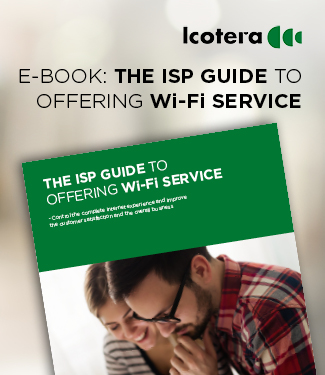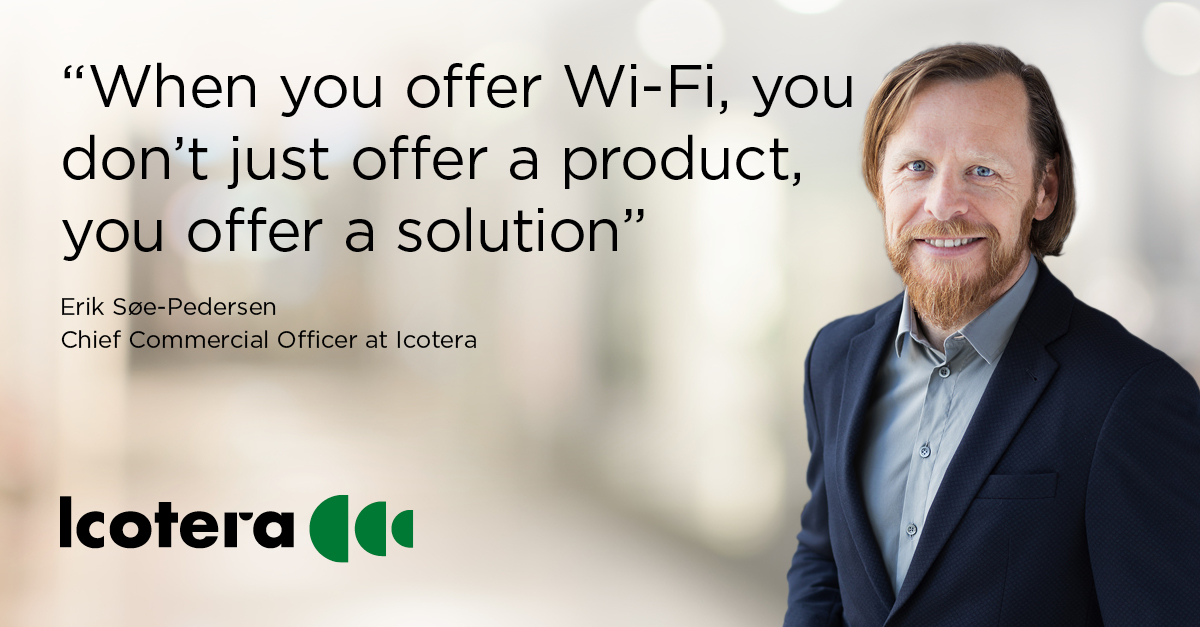While there are huge advantages for internet service providers (ISPs) who choose to offer Wi-Fi on top of the fiber termination, it is not as simple as “turning on” the Wi-Fi. There may be attractive shortcuts, but Icotera advocates that to make a profitable business out of Wi-Fi, ISPs need to make a strategic choice about how to approach their Wi-Fi offering in the first place.
A fear of support costs running wild prevents many ISPs from offering Wi-Fi to their end-consumers. Yet, it does not have to be that way. Controlling the whole value chain puts you in a better position to offer more efficient and reliable support, and the service itself allows for great upselling opportunities…
But only if you do it right. Wi-Fi may be tricky:
- There are so many unknowns when installing Wi-Fi in people’s homes. Where do they place their router? What is the floor plan? How thick are the walls? And where is the TV placed? While Wi-Fi signals are invisible to the human eye, there are so many physical circumstances that affect the performance, and hence the customer experience, explains Icotera’s Chief Commercial Officer, Erik Søe-Pedersen.
By controlling the complete internet delivery, ISPs can create happy end-consumers having Wi-Fi with full in-home coverage – and make it a profitable business at the same time.
Learn how in our e-book The ISP Guide to Offering Wi-Fi Service
- Find the e-book here
Because of this, making Wi-Fi a profitable business is, according to him, about having the right priorities from the very outset:
- ISPs need to make a strategic choice about how to approach the Wi-Fi offering. It doesn’t do any good to go with a solution of poor-quality equipment that is not capable of running the speeds you are offering. The end-consumers might be buying a 500 or even a 1000 Mbit connection yet ends up with speeds of 20-40 Mbit in some areas of the home. Therefore, high-quality customer premise equipment (CPE) is a prerequisite, if you want to offer high-end internet performance. All things considered, end- users don’t care about Wi-Fi specs, they just expect a wireless signal, when and where they need it.
Offer a solution, not a product
But high-quality CPE won't do the job alone.
- When you offer Wi-Fi, you don’t just offer a product, you offer a solution. It is a matter of taking responsibility and adopting a long-term outlook - focus on making an offering that lasts. Of course, you can opt for easy fixes with DIY solutions, letting end-consumers handle the installation themselves, explains Søe-Pedersen and continues:
- But there are rarely any winners with this approach. The end-consumers get frustrated when they cannot manage to get the Wi-Fi to work the way they expected, and ISPs often end up spending a lot of time on support. Despite the fact that many ISPs actually go for this to minimize on-site support in the first place, this is rarely a profitable strategy.
Søe-Pedersen explains why:
- It might be good for keeping installation costs down in the short term, but it is rarely a profitable approach in the long run. Considering all the unknown factors that affect the performance, you lose control when you do it this way. Often, this means more in-home issues in the long run, and less satisfied consumers who – in the end – may turn to other providers.
Instead, he sees quality installation as an essential component of producing satisfied end-consumers.
 "If you get it right in the first place, end-users will experience a better performance
"If you get it right in the first place, end-users will experience a better performance
and become more satisfied with your service in the process.
What’s more, you often won’t have to touch it again for years – and that’s
how installations become cash cows for your business."
Erik Søe-Pedersen, Chief Commercial Officer at Icotera
- When providing Wi-Fi, we recommend that ISPs sell the installation as part of the package. Because when you have been in the home and ensured that the router and, optionally, the access points are placed correctly, you are one step ahead in providing a better in-home Wi-Fi performance. And it will often save both you and the end-users from problems afterwards. I recognize that it is a price-raising action to handle the installation, but it is a one-time investment. If you get it right in the first place, end-users will experience a better performance and become more satisfied with your service in the process. What’s more, you often won’t have to touch it again for years – and that’s how installations become cash cows for your business, Erik Søe-Pedersen explains.
No one-size-fits-all solution
At the same time, Erik Søe-Pedersen emphasizes that for ISPs there is rarely a one-size-fits-all solution when it comes to Wi-Fi.
- A huge three-floor villa cannot be expected to manage with the same set-up as a small dormitory. Size, architecture, construction materials and location, among other factors, all need to be taken into consideration. Most ISPs do know their end-users very well, but it’s a matter of leveraging this knowledge and having the right personas and user scenarios in place, so you know which solutions to offer to which end-consumers, Erik Søe-Pedersen explains.
The higher the speed, the greater the router quality
Ultimately, offering Wi-Fi is not an equal job in all markets. There are high-end markets that are more mature than others. In these markets, bandwidths have increased and will continue to do so. And that should be reflected in the hardware offered by ISPs.
- It is vital to respond to the speeds in one’s market and offer solutions that can actually match the speed provided. While solutions with low bandwidth can do with less, premium solutions simply require premium customer premise equipment and premium advisory from the ISP, Erik Søe-Pedersen ends.
FAST TRACK.....
- To make Wi-Fi a profitable business you need to make strategic choices and have a clear approach from the beginning.
- Offer a solution, not just a product: Take control and conduct the installation process; the investment will make its money back when you often won’t have to touch it again for years –that’s how installations become cash cows for your business.
- There is rarely a one-size-fits-all solution when it comes to Wi-Fi: Building size, architecture, construction materials and location, among other factors, all need to be taken into consideration.
![]() If you want to know more about the benefits of offering Wi-Fi or would like an advice
If you want to know more about the benefits of offering Wi-Fi or would like an advice
on how to structure the set-up, please reach out at sales@icotera.com or
give us a call at +45 70 10 00 33.
WANT to Deliver an internet experience – or just a box?
By taking control of the complete internet delivery, from the fiber connection to the Wi-Fi service, ISPs can create happy end-consumers having high-performing Wi-Fi with full in-home coverage – and make it a profitable business at the same time.
- Learn how in our e-book The ISP Guide to Offering Wi-Fi Service - Find the e-book here
- You might also find our guide with dos and don’ts for ISPs delivering Wi-Fi interesting.
Find the guide: 5 mistakes to avoid when offering Wi-Fi here




